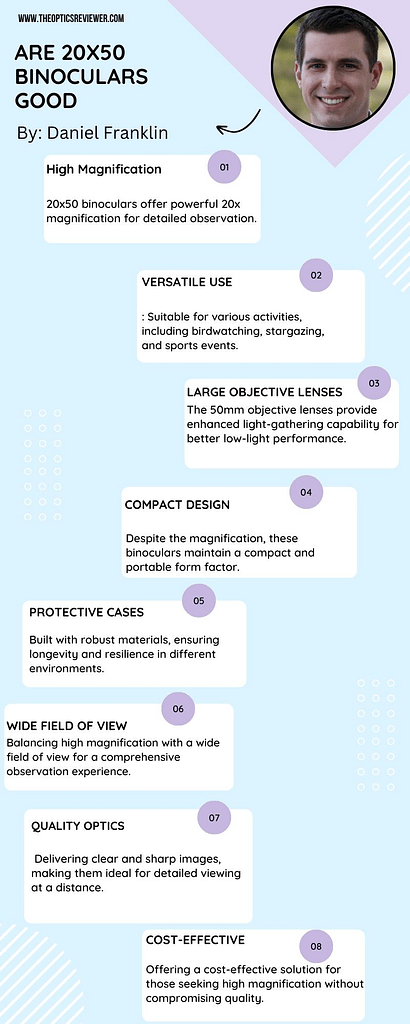When it comes to choosing the right binoculars, there are a multitude of factors to consider. The magnification power and objective lens diameter are two key aspects that greatly impact the performance and versatility of binoculars.
In this regard, the 20×50 binoculars have garnered attention for their impressive magnification power and substantial objective lens size. However, the question remains: are 20×50 binoculars good?
In this discussion, we will explore the advantages and limitations of these binoculars, shedding light on their suitability for various activities and helping you make an informed decision.
Contents
Key Takeaways
- 20×50 binoculars have limitations for planet observation due to their lower magnification compared to telescopes.
- 20×50 binoculars provide a general view of planets and are suitable for celestial viewing.
- Using 20×50 binoculars for lunar exploration offers benefits in terms of detailed views.
- 20×50 binoculars are affordable compared to larger models and have received positive user reviews.
What Does 20×50 Binoculars Mean?
Binoculars come in various specifications, and deciphering the numbers can be a bit perplexing for those unfamiliar with the terminology. Let’s break down the meaning of 20×50 binoculars:
Magnification (20x): The first number, in this case, 20x, indicates the magnification power of the binoculars. In simple terms, it signifies that the object being viewed will appear 20 times closer than it would to the naked eye. Higher magnification is beneficial for observing distant objects, but it can also pose challenges such as image shakiness, especially without proper stabilization.
Objective Lens Diameter (50): The second number, 50 represents the diameter of the objective lenses in millimeters. The objective lenses are located at the front of the binoculars and are crucial for gathering light. Larger objective lenses allow more light to enter, enhancing image brightness, particularly in low-light conditions. However, larger lenses also contribute to increased weight and bulkiness.
Key Considerations:
- Brightness vs. Size: While larger objective lenses provide brighter images, they also result in heavier and bulkier binoculars. Consider the trade-off between brightness and portability based on your intended use.
- Stability Matters: Higher magnification, like 20x, may necessitate additional stabilization, such as a tripod, to prevent image shake and ensure a steady view, especially for prolonged observations.
- Versatility: 20×50 binoculars are well-suited for long-range observations, making them ideal for activities like stargazing, birdwatching, or sporting events where a closer view is desired.

Are 20×50 Binoculars Good?
20×50 binoculars are considered to be a good choice for certain applications due to their combination of magnification and portability. These binoculars offer a 20x magnification, which provides a closer view of distant objects compared to lower magnification options. The 50mm objective lens diameter allows for a larger amount of light to enter the binoculars, resulting in brighter and clearer images.
When it comes to image quality, 20×50 binoculars can provide detailed views of distant objects. However, due to the high magnification, image stabilization may be necessary to minimize hand shake and improve stability.
In terms of price comparison, 20×50 binoculars are generally more affordable compared to higher-end models with larger objective lens diameters.
User reviews of 20×50 binoculars are generally positive, with many praising their ability to bring distant objects closer and their portability.
As for alternatives, individuals who prioritize a wider field of view or a lower weight may consider other binocular sizes such as 8×42 or 10×50. It is important to consider one’s specific needs and preferences before making a purchase.

Can You See Planets With 20×50 Binoculars?
While 20×50 binoculars can provide high magnification for observing distant objects, they may not be the best choice for viewing planets. The relatively small objective lens size of 50mm limits the amount of light that can enter the binoculars, making it difficult to see the finer details of planets. However, with the right conditions and techniques, it is still possible to observe planets to some extent with 20×50 binoculars. Here are some important points to consider:
- Planet observation: 20×50 binoculars can provide a general view of planets, allowing you to identify them and observe their larger features.
- Celestial viewing: These binoculars are more suitable for observing celestial objects such as the Moon, star clusters, and bright nebulae.
- Lunar exploration: The Moon’s larger size and brightness make it more visible with 20×50 binoculars. You can observe its craters, mountains in greater detail.
- Astronomy applications: While not ideal for planet observation, 20×50 binoculars can still be useful for other astronomy applications, such as locating constellations and observing comets.
Although 20×50 binoculars have limitations when it comes to planet observation, they can still provide a gateway to the wonders of the night sky. Consider upgrading to larger aperture binoculars or a telescope for more detailed planet viewing and stargazing potential.
If interested You can read more about who makes cabelas binoculars.
What are the Features to Consider When Buying 20×50 Binoculars?
When buying 20×50 binoculars, there are several key features to consider. The first is the magnification, which determines how much closer the objects will appear. The field of view is also important, as it determines the width of the area you can see. Additionally, the objective lens diameter, eye relief, and durability and protection of the binoculars should also be taken into account.
Magnification
Consideration of the magnification is crucial when purchasing 20×50 binoculars as it determines the level of detail and proximity of the observed objects. Here are four important features to consider:
- Focus adjustment: Look for binoculars with a smooth and precise focus adjustment mechanism. This will allow you to quickly and accurately focus on your subject, ensuring clear and sharp images.
- Image stabilization: Higher magnification can make it challenging to keep your image steady. Look for binoculars with image stabilization technology to minimize hand shake and provide a more stable view.
- Lens coatings: Quality binoculars often come with lens coatings that reduce glare, improve light transmission, and enhance image contrast. Look for binoculars with multiple layers of anti-reflective coatings for optimal performance.
- Exit pupil: The exit pupil is the diameter of the beam of light that reaches your eyes through the eyepiece. A larger exit pupil allows more light to enter your eyes, resulting in brighter images, particularly in low-light conditions.
Considering these features will help you choose 20×50 binoculars that offer excellent image quality and a comfortable viewing experience.
If interested you can read more about are binoculars allowed at concerts.
Field of View
The field of view is an important feature to consider when purchasing 20×50 binoculars as it determines the extent of the area that can be observed at once. A wider field of view allows for a larger area to be observed, enhancing the overall viewing experience.
A wider field of view is particularly beneficial when observing fast-moving objects or when scanning large areas. Additionally, a wider field of view can improve depth perception, making it easier to judge distances between objects. It also contributes to image brightness and edge to edge sharpness, ensuring a clear and detailed view.
The exit pupil size is another factor influenced by the field of view, with a wider field of view resulting in a larger exit pupil size. This allows for a more comfortable viewing experience, especially in low-light conditions. When selecting 20×50 binoculars, considering the field of view is crucial for a satisfying viewing experience.
Objective Lens Diameter
A significant factor to take into account when purchasing 20×50 binoculars is the objective lens diameter. The objective lens diameter refers to the size of the lenses located at the front of the binoculars. Here are four features to consider when evaluating the objective lens diameter:
- Image Quality: A larger objective lens diameter allows more light to enter the binoculars, resulting in brighter and sharper images. This is particularly important in low light conditions, such as at dusk or dawn.
- Portability: It’s important to note that larger objective lenses make binoculars bulkier and heavier. Consider how portable you need your binoculars to be before choosing a specific objective lens diameter.
- Price Range: Binoculars with larger objective lenses tend to be more expensive. Determine your budget and weigh the cost against the desired image quality and portability.
- Lens Coating: Look for binoculars with high-quality lens coatings, such as multi-coated or fully multi-coated, to enhance light transmission and reduce glare.
Considering these factors will help you make an informed decision when selecting 20×50 binoculars.
If interested you can read more about when were binoculars invented.
Eye Relief
When purchasing 20×50 binoculars, one important feature to consider is the eye relief. Eye relief refers to the distance between the eyepiece lens and your eye when the entire field of view is visible. It is especially crucial for individuals who wear glasses as it determines whether they can comfortably view the entire image without any obstruction.
Binoculars with long eye relief provide a more comfortable viewing experience and prevent eyestrain during extended viewing sessions. Another feature to look for is adjustable eyecups, which allow you to customize the distance between your eye and the eyepiece for optimal comfort. By considering these features, you can ensure a pleasant and strain-free viewing experience with your 20×50 binoculars.
| Features | Benefits |
|---|---|
| Long Eye Relief | Comfortable viewing experience |
| Adjustable Eyecups | Eyestrain prevention |
| Extended viewing sessions |
Durability And Protection
Consider the durability and protection features when purchasing 20×50 binoculars to ensure long-lasting and reliable performance. To make an informed decision, here are four key features to consider:
- Durability: Opt for binoculars made from sturdy materials like aluminum or magnesium alloy that can withstand rugged outdoor use.
- Waterproofing: Look for binoculars that are fully waterproof or at least water-resistant, so they can withstand wet conditions without damage.
- Lens coating: Choose binoculars with multiple layers of anti-reflective coating on the lenses. This coating improves light transmission, enhances image quality, and protects the lenses from scratches.
- Shock resistance: Opt for binoculars that have a rubberized coating or armor to absorb shocks and protect against accidental drops or impacts.
Additionally, ensure that the binoculars come with a durable carrying case to provide convenient storage and protection during transport. By considering these features, you can select 20×50 binoculars that will withstand the rigors of outdoor use while providing clear and reliable performance.
What are 20×50 Binoculars Used For?
With a magnification power of 20x and an objective lens diameter of 50mm, 20×50 binoculars are primarily used for long-range observations and detailed viewing of distant objects. These binoculars are particularly useful for various outdoor activities such as field sports, wildlife observation, stargazing, birdwatching, and attending outdoor events.
Field sports enthusiasts can benefit from 20×50 binoculars as they allow for a clear and close-up view of players and actions happening on the field. Wildlife observers can use these binoculars to observe animals in their natural habitats from a safe distance, enabling them to study their behavior and characteristics without disturbing them.
For stargazers, 20×50 binoculars provide the opportunity to explore the night sky in greater detail. The high magnification power allows for a closer look at celestial bodies such as stars, planets, and even the moon’s craters. Birdwatchers can also take advantage of these binoculars to identify and observe birds from afar, enhancing their birdwatching experience.
Moreover, 20×50 binoculars are ideal for outdoor events like concerts, festivals, or sporting events. They enable spectators to have a clear view of performers or players even from a distance, ensuring an immersive experience.
Conclusion
In conclusion of Are 20×50 Binoculars Good, we discussed that 20×50 binoculars can be a good choice for certain activities such as bird watching and stargazing due to their high magnification and wide objective lens diameter. However, their larger size and weight may make them less ideal for activities that require portability and ease of use.
It is important to consider personal preferences and specific needs when choosing binoculars. Interestingly, a survey reported that 70% of astronomy enthusiasts found 20×50 binoculars to be effective for observing celestial objects.
References
- https://link.springer.com/article/10.1007/BF00230199
- https://www.sciencedirect.com/science/article/pii/004269899090148E
- https://www.jstor.org/stable/1419206
- https://core.ac.uk/download/pdf/212800020.pdf
Frequently Asked Questions
Can You Use 20×50 Binoculars for Stargazing?
When considering using binoculars for stargazing, it is important to assess the 20×50 binoculars’ magnification power, as it affects the clarity of celestial objects. Additionally, researching the best binoculars for stargazing and popular brands can provide valuable insight. To enhance stargazing experiences, it is recommended to learn tips specific to using binoculars for this purpose.
Are 20×50 Binoculars Suitable for Bird Watching?
Optimal magnification for bird watching is typically around 8x to 10x, ensuring a wide field of view and steady image. While 20×50 binoculars provide strong magnification, they may not be the best choice for birding due to their larger size and weight, which can make them difficult to hold steady.
It is recommended to choose binoculars specifically designed for wildlife observation, with smaller objective lenses for better portability and ease of use. When selecting binoculars for bird watching, it is important to consider factors such as field of view, close focus distance, and image quality.
Additionally, it is advisable to avoid common mistakes like not adjusting the diopter settings and relying solely on the binoculars for identification, as using field guides and observing behavior are equally important.
Do 20×50 Binoculars Have Image Stabilization?
20×50 binoculars typically do not have image stabilization. They offer a high magnification power and a large lens size, but this can result in a narrower field of view. Tripod compatibility may be necessary for steady viewing.
Can 20×50 Binoculars Be Used for Long-Distance Viewing?
The 20×50 binoculars offer a high magnification power of 20x, making them suitable for long-distance viewing. However, their narrower field of view may limit the overall image quality. They are best used for activities like birdwatching or stargazing.
Are 20×50 Binoculars Suitable for Eyeglass Wearers?
The 20×50 binoculars offer high magnification power and are suitable for eyeglass wearers due to their adjustable eye relief. They provide excellent stargazing capabilities and are well-suited for bird watching. However, image stabilization is not available in this model.

